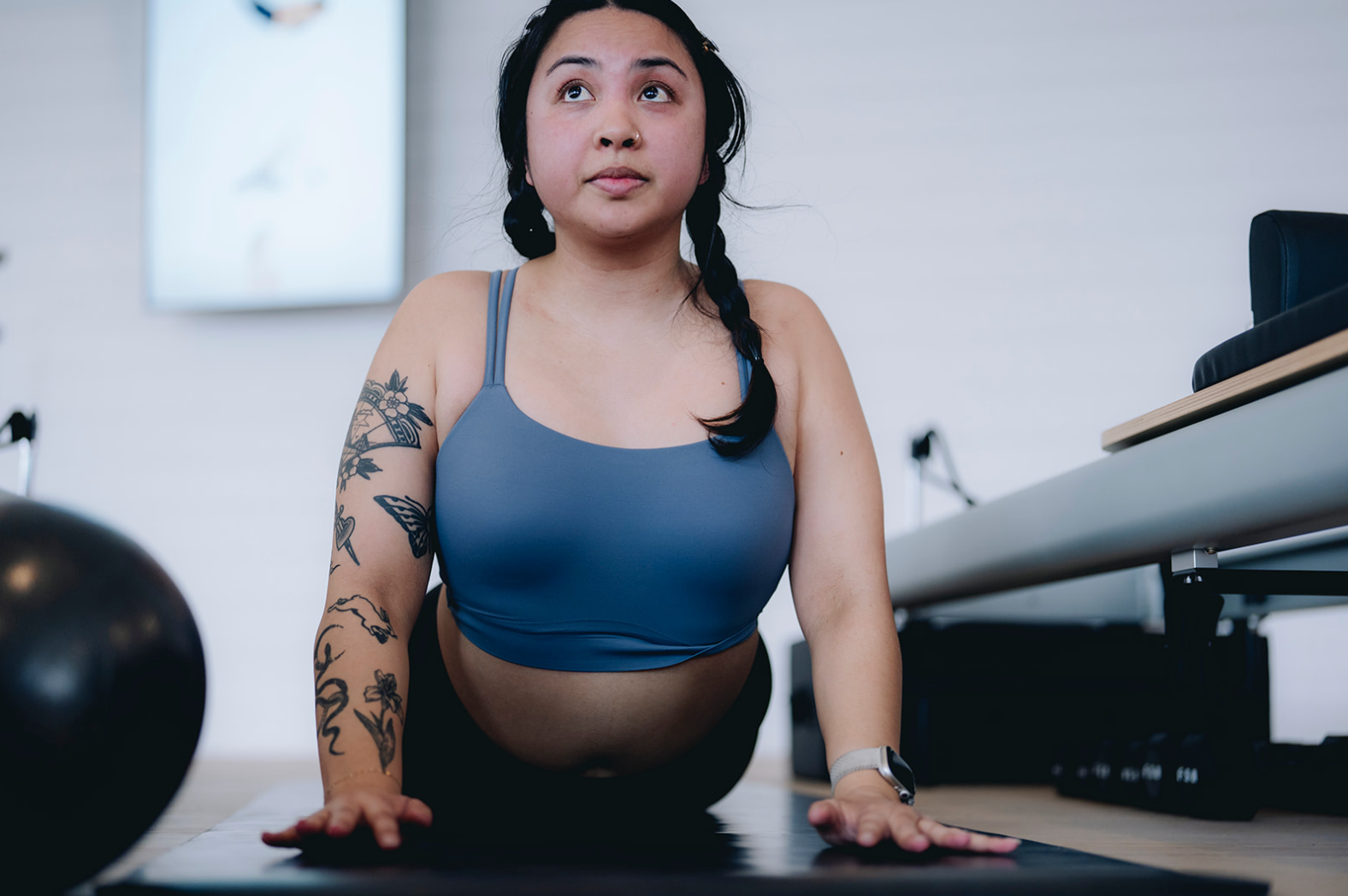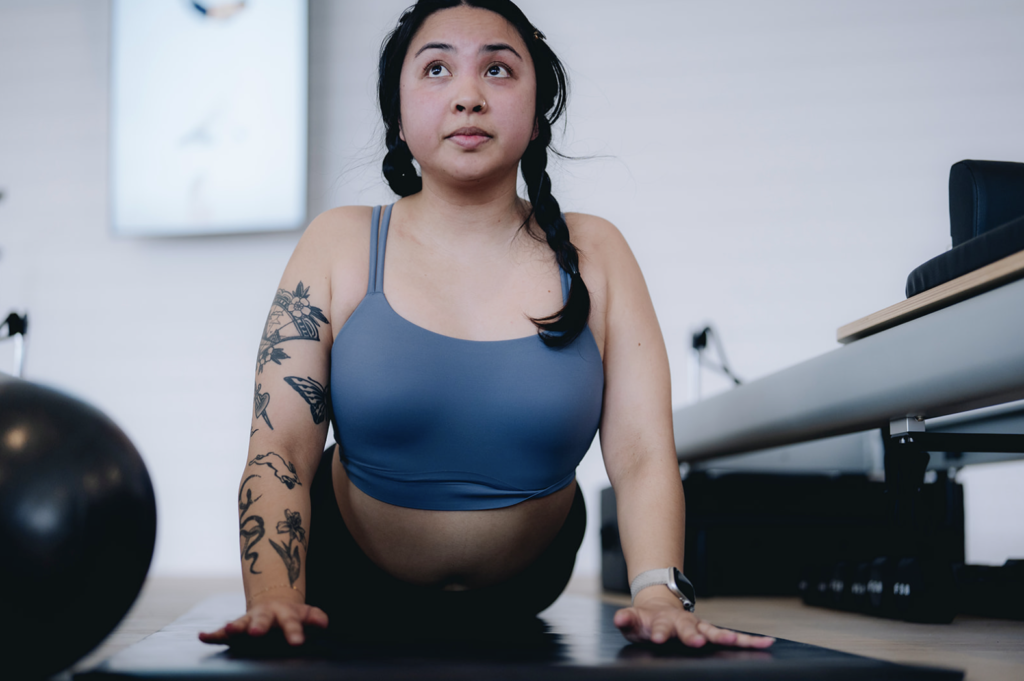
The Benefits of Yoga for Back Pain
Back pain is a far more common than you might think, with over 619 million people globally experiencing back problems¹.
It’s an ailment that affects people of all ages and backgrounds, but it’s especially common among those who lead sedentary lifestyles, as well as sufferers of conditions like sciatica and during pregnancy.
Yoga has gained popularity for its ability to reduce back pain – and many are not only discovering the back-stabilizing benefits of yoga during pregnancy, but the various advantages of low-impact workouts for body alignment and injury prevention, too. Below, we’ll be exploring how yoga helps with back pain, walking you through our top yoga exercises for back flexibility and how FS8 workout classes can help. Since FS8 encompasses Pilates, Tone, and Yoga, it’s the perfect place to master some of these poses and help to alleviate that nagging pain. Let’s get started!
Benefits of yoga for back pain
If you have back pain, yoga provides a holistic approach for both alleviating back discomfort and preventing it from returning. Read on as we take you through the range of benefits you can enjoy with back-centric yoga.
Elevates strength
Yoga improves back strength and overall body balance through a combination of mindful postures and movements. Exercises such as planks or bridges develop your core muscles, which play a key role in supporting your spine.
Lower back flexibility yoga movements such as the cobra and downward dog target your entire back: increasing your back muscle strength and endurance, which is essential for comfortable bending, lifting, twisting and reaching.
Enhances balance
The increased core and back strength that comes from yoga exercises for spine alignment helps to keep your body upright while standing or sitting.
Keeping your body in its natural position is one of the central benefits of pilates for over 60s, as it helps improve coordination and prevent muscle imbalances.
Supports body relaxation
There’s a variety of ways yoga can help the muscles in your back relax. For one, you’ll notice the physical relief that comes from yoga exercises for back flexibility, and its ability to ease the discomfort caused by muscle stiffness.
For another, the focus on mind-body connection can calm your nervous system and decrease muscle tension arising from anxiety or stress, which helps you sleep. It’s why we recommend doing yoga for sleep exercises every evening. Coming off an FS8 class, you’ll find exercises worked in to your cool down to help support your body and return to the relaxation – rest and digest – state of mind.
Improves posture and alignment
Many yoga exercises engage the muscles along your back, such as your erector spinae, latissimus dorsi and rhomboids. Developing these muscles helps to align your posture, supporting your spine and stopping you from slouching or arching your back.
Yoga back exercises focus on maintaining a neutral spine, which is your back’s natural position. By practicing these exercises, you help restore the healthy curvature of your spine, mitigating the risk of future misalignment.
Increased body awareness
Lower back flexibility yoga encourages mindfulness, making you more aware of the sensations in your body and how they’re interconnected. By learning to focus your attention and mastering pilates breathing techniques, you gain more awareness of where the tension, aches or discomfort in your back lie. This way, you can avoid those movements that don’t feel quite right.

Top 7 yoga poses for back pain
To enjoy the benefits of yoga for back pain, you need to consistently perform a variety of back-focused movements or poses. Below, we’ll teach you how to perform seven poses from all types of yoga to improve back comfort.
1. Child’s pose
This pose releases tension by gently stretching your back, hips and thighs.
To perform the child’s pose:
- Start on your knees and lower your upper body to the floor.
- Extend your arms out in front of you.
- Rest your forehead on the floor and breathe deeply.
2. Cat/cow
A dynamic movement that promotes back mobility and flexibility.
To perform the cat/cow pose:
- Start on all fours.
- Inhale, arch your back and look up (cow position).
- Exhale, round your back and tuck your chin inwards (cat position).
- Repeat these movements eight to twelve times.
3. Downward–facing dog
This full-body yoga exercise for spine alignment is a fantastic way to learn how to improve balance with yoga and pilates, as it lengthens your back and strengthens your arms and legs.
To perform the downward-facing dog:
- Start on all fours.
- Extend your arms out in front of you, placing your palms on the floor.
- Lift your hips up and back, holding yourself up with your arms. This should create an upside-down “V” shape with your body.
- Hold this position for 15 to 30 seconds.
4. Reclining twist
This exercise stretches your glutes, chest, and shoulders – and can ease lower back, spine and hip tension.
To perform the reclining twist:
- Begin by lying flat on your back.
- Bring your knees toward your chest, giving them a gentle hug.
- Extend your arms out to your side, forming a “T” shape with your body.
- Inhale and lower both of your knees to one side, ensuring your feet stay together and your shoulders are on the ground.
- Breathe deeply and hold this position for 30 seconds, then switch sides.
5. Bridge pose
A key exercise for lower back flexibility yoga, bridge pose helps strengthen your lumbar spine, glutes and legs – and is a fantastic beginner exercise for learning how functional strength works.
To perform the bridge pose:
- Lie on your back, with your knees bent and feet flat on the floor, hip-width apart.
- Press your feet into the floor, lifting your hips upward until your back is parallel with your upper legs.
- Hold this position for 30 seconds, keeping your shoulders and arms grounded.
6. Pigeon pose
This pose releases tension in tightness in the lower back by opening your hip flexors and stretching your hips, glutes and thighs.
To perform the pigeon pose:
- Begin on all fours.
- Bring your right knee toward your right wrist, placing your right ankle near your left wrist (your right knee should still be flexed).
- Extend your left leg straight behind you. Slightly bend your left knee if that’s more comfortable.
- Inhale and bring your torso upright, doing your best to keep your back straight.
- Hold this position for 30 seconds and repeat on the other side.
7. Cobra pose
The cobra pose is an empowering lower back flexibility yoga exercise, increasing comfort and mobility in the spine.
To perform the cobra pose:
- Lie face down on the floor, with your legs straight behind you.
- Place your hands on the floor, with your palms under your shoulder and elbows tucked by your side.
- Inhale, engage your core, and gently lift your chest upwards, using your arms for support as you do.
- Once you feel a light stretch, hold the position for 30 seconds.
Yoga safety tips for back pain
Yoga exercises have the potential to relieve and prevent back pain – but you need to be constantly mindful of the way you move, to not worsen any issues. Here are three safety tips when performing yoga exercises for back flexibility.
Use props for support: Props like blocks, bolsters and blankets can be used to make poses more comfortable – especially for poses that require extra flexibility, or that may cause slight discomfort from pressing your joints into the floor.
Modify poses for comfort: Change poses to suit your body. Some poses may require you to develop more strength or flexibility to perform (for example, you can make the cobra pose easier by bending your elbows into baby cobra) and it’s better to hold an easier position than push through an uncomfortable one in the incorrect posture. Modifications are available in every FS8 class, always ensure you have correct form to avoid any potential chance of injury.
The benefits of yoga for back pain can help you retake control of your movement and health. And, if you want to continue elevating your body, explore how to build your core muscles with strength exercises next.
1 https://www.who.int/news-room/fact-sheets/detail/low-back-pain
2 https://yinyoga.com/yinsights/holding-for-time/

